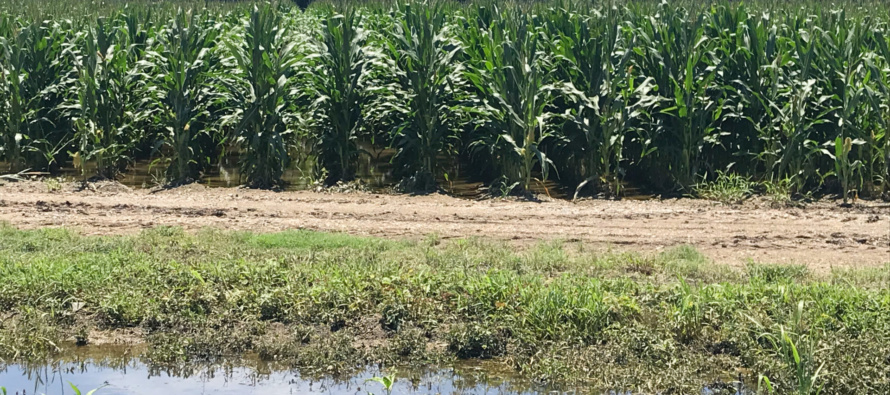Estimating Nitrogen Loss in Corn from the June Flood

Related Articles
- 2010 Soybean And Corn Variety Trial Data 3
- Fertilizing Cotton with Poultry Litter 5
- Spring Nitrogen Fertility Suggestions for Wheat 0
Latest Tweets
The recent extraordinary rainfall and associated flooding has generated substantial concern about nitrogen (N) loss and fertility management in corn. The unique situation about this year’s event is it occurred much later in the season than we normally experience. Therefore, we will discuss how this timing affects estimating losses and associated nutrient management.
Nitrogen is subject to considerable loss from plentiful rainfall which saturates soils for an extended time. Two N loss pathways are possible: one physical, and one chemical. Leaching is the physical movement of nitrate-form N down through the profile. Nitrate does not bind to soils like the phosphate ion, so it moves downward with soil drainage. The quantity of N lost from the rooting zone depends on soil texture, the presence of restrictive soil layers, such as tillage pans, and the initial soil water content. The primary loss resulting from saturated conditions and flooding is by denitrification. Denitrification is the microbial conversion of nitrate in anaerobic, saturated soils to gaseous forms such as nitric oxide, nitrous oxide, or dinitrogen which diffuse through the soil and dissipate into the atmosphere. Two to three days of saturation are required for the process to begin.

Corn uses most of its nitrogen by tassel, leaving only the remainder subject to loss depending on your crop stage.
The amount of nitrogen loss depends primarily upon how long soil remains saturated – not necessarily the abundant amount of rainfall. Fertilizer application timing, nitrogen source, and quantity applied generally all affect nitrogen vulnerability to loss as well. The denitrification rate will likely be at least 5% during the summer. However, this year’s extraordinary rain and flood occurred much later in the season than normal. Since much of our corn crop has progressed to near tassel stage or beyond, much of the nitrogen fertilizer has already been used by the crop and is thus no longer vulnerable. In fact, about 65% of N is used by corn by the tassel stage to fully develop the vegetation. Accordingly, this will greatly reduce the potential N loss associated with this mid-season event.
Nitrogen application timing and fertilizer source affect the amount of N in the nitrate form, which is subject to denitrification. The following table estimates percentage of fertilizer present in the nitrate form for different nitrogen sources depending upon the time after application (adopted from “Evaluating Flood Damage in Corn,” Lee et al., Univ. of Kentucky, AGR-193).
For example, if you applied 260 pounds/a of N and your corn is tassel stage, then 91 pounds N/a are subject to loss (260 x 35% of N not used by the corn). If the nitrogen source was urea applied primarily within the past three to six weeks before the flood, about 57 lbs of N (91 x 62.5%) are present in the nitrate form. Each day of saturation after the initial two days of rain results in an estimated daily loss of 2.84 lbs. N (57 x 5%). Thus, if your field was saturated for 7 to 10 days, then estimated N loss is about 14 to 23 lbs./a.





Let me tell You a sad story ! There are no comments yet, but You can be first one to comment this article.
Write a comment